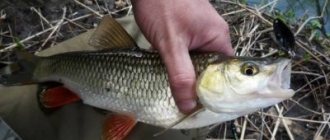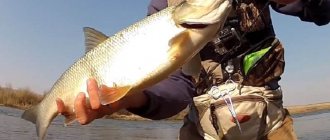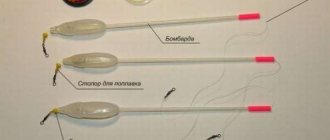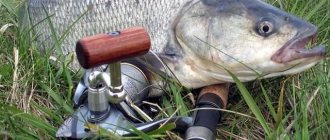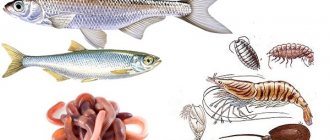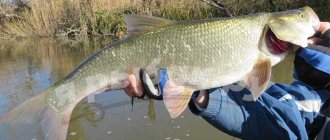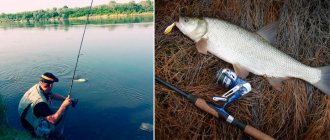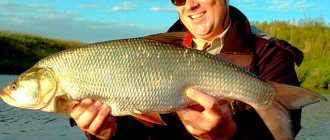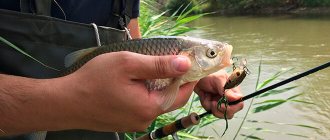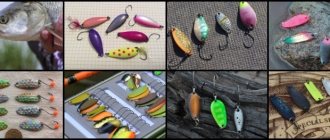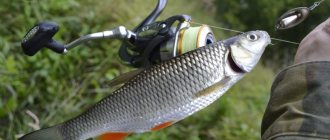Yuri 06.11.2020 589
Since the asp acts as a rather aggressive toothless predator, not all baits are suitable for it. The lack of teeth forces him to feed on fry. To catch this predator, fishermen often use live bait. Since catching a good fry can be a lot of trouble, we present to your attention the best artificial baits for asp. Experienced Astrakhan fishermen have learned to select lures in accordance with the preferences of the predator, and we are ready to pass on this interesting experience to novice spinners.
To make baits, metal or silicone is used - small fish with 1 or several hooks. The presence of a variety of baits in the angler’s arsenal increases the likelihood of leaving with a decent catch.
- Interesting fact! When hunting for fry, the asp jumps out of the water and makes a slap sound to scare its prey. The fry freezes in fear, and the asp only needs to catch him in the mouth.
Devonian
Since the asp lives in the upper layers of reservoirs, a spoon called Devon is suitable for it. The bait is available in various modifications - cylindrical, flat or square. The cylindrical Devon has blades on the sides that allow the spoon to rotate. Lures are available in silver or gold colors - made of metal. Additional weight is not required, since a length from 40 to 120 mm with a diameter of 20-35 mm indicates an impressive weight of the bait.
The market is gradually replenished with plastic models - their popularity among asp fishing enthusiasts is increasing. However, plastic Devon does not yet allow achieving the same effectiveness as a metal bait. In Devon there is one large tee, or two hooks on the sides. With such a bait it is easy to achieve accurate long-distance casting. We reel in the fishing line - the spinner rotates, imitating the movement of a small fish. The Volga is a deep river with a strong current, so it is better to use Devon “Meteor” or “Bumblebee” here.
Devon spinner for fishing
Disadvantage: during the wiring process, the fishing line gets very twisted, but the problem is solved with a swivel. To increase the service life of such a spoon, we store the Devon dry without drops of water, having previously blown the bait through. Drops may remain in the bearings - this can damage the rotation.
Where and when to catch asp
The activity of the asp begins after spawning. True, sometimes in April, before the mating season, asps are caught on a worm or live bait.
An excellent bite begins immediately after spawning. The difficulty of fishing lies in the cold and muddy water. That’s why baits move slowly and it’s better to rely on baits that make a sound. For example, a dragonfly, a mole cricket or a beetle. In such cases, accurate casts with a splash are effective. Just don’t overdo it, otherwise you’ll scare off the river hunter.
In early May, they catch May beetle larvae and adult beetles. This bait is so high in calories that the asp grabs it after spawning without even caring about his life and thereby neglects all the rules of caution.
May beetle larvae are placed on hooks No. 7-8. May beetles are mounted on the chest and the sting is inserted into the lower abdomen. A hook is inserted into the mole cricket from the belly side and passed under the eye. If the mole cricket is large, then it can be baited on two hooks.
Grasshoppers, mole crickets, and beetles spread their wings. Use leashes up to a meter long made of fluorocarbon fishing line. At this time, the asp is in places with rapids, behind long capes. After casting the bait, make sure that it drifts freely and gradually sinks in front of the float. They hook when the float suddenly moves to the side or drowns.
You can also use a sbirulino float instead of a regular float and weight. By the way, in the spring the fish lurks in ambush, and in the summer it prowls the river. Most often you can catch this predator in places with reverse currents. The predator stands on the border of the currents.
When the water has warmed up, start fishing with live bait. Fish of 7-8 cm are used: goby, minnow, crucian carp, chub, bleak or dace.
Live bait is placed on two hooks. Moreover, one hook must be placed in the back of the baitfish. Otherwise, the predator will remove the bait with impunity.
Another signal of the asp’s location is the so-called “asp fight,” which takes place in places where fry gather—the predator’s food. In such places, individuals weighing 0.5-6 kg are caught.
“Asp fighting” is a rapid attack by a predator from an ambush on a flock of fry. He sharply hits the water with his tail and then slowly collects the stunned small fish. Moves aside, waits and repeats the attack again.
So, such places could be:
- Sand spits with a slight slope under the water. The depth in such places is from 20 cm to 40 cm.
- Sandy beaches with dense thickets of reeds on the side and a sharp increase in depth up to 1 meter.
- Areas of underwater shoals, where the bottom changes from 20 cm to 40-60 cm and gradually increases to one meter, the top to two meters, etc.
- Individual bushes of vegetation or snags protruding in the middle of the water.
- Splashes of a predator in the middle of the river.
Button
We continue the series - the best baits for catching asp, we present to your attention a do-it-yourself bait - this is a round button with wire loops and a central thickening. The bait is easy to deliver to a given target; it adheres to a given flight path. The casting distance is determined by the weight, maximum – 80 m. The nozzle is equipped with a triple hook and feathers of a certain color scheme.
Spinner button for asp
For such a bait, the subtleties of wiring should be taken into account. To fish the upper and middle layers of water, fast active fishing is used. At the same time, when moving quickly, air bubbles form behind the button, to which the asp, rest assured, will react like never before.
What types of twisters are there?
The fishing industry does not stand still, but is constantly progressing, inventing new gear and bait. Now, not only the usual classic twisters are supplied to the shelves, as was the case ten years ago. The modern market is flooded with various options and modifications within this category of silicone. There are unusual and very successful models, and there are simply original ones, but nothing more.
Previously, twisters were made of banal soft silicone material. It had sufficient plasticity and elasticity. Thanks to this, the bait behaved agilely in the water, creating attractive vibrations, steadfastly withstood the bites of a predator and confidently stayed on the hook.
Photo 1. Variety of twisters.
Today, the so-called “edible” rubber has come to the fore. It contains tasty salts and amino acids, as well as active attractants. The result is a bait that smells attractive and does not cause alertness to a predator once it is in its mouth.
The disadvantage of “edible” is its weak strength. The twister quickly breaks and becomes unusable. Even a perch or asp with its toothless mouth can tear the bait to such a state that it will no longer stay on the hook and will have to be replaced with a new one. True, the extraordinary catchability outweighs this disadvantage and it’s worth coming to terms with it, especially since silicone is considered a consumable material by advanced fishermen and is not particularly taken care of.
Classic twisters made of ordinary rubber, “inedible”, continue to be used today. Of course, they have lost their former popularity, but they have retained their working properties, so there is no point in abandoning them altogether.
Pinwheel
How to choose the right spinner for an asp? More on this later. The bait is distinguished by the presence of a petal that rotates around its axis, there is also a hook and a tail section. Strong hydroacoustic vibration is generated during rotation. The lateral line of a predator perfectly transmits the signal to attack. The asp's frequent landings on the spinner indicate two things - either he perceives the spinner as a fry, or it irritates him. It's up to you to decide, but the fact remains that the turntables in Astrakhan work for asp, especially in the fall.
Asp spinners
The efficiency of catching asp on a spinner increases if you alternate slow and fast retrieves. Two or three slow turns are followed by two or three quick jerks of the reel. If we go fishing in sunny weather, then the best spinner for asp is copper color; cloudy weather requires the use of silver shades.
Spreader for asp
The oscillator does not produce rotations, but vibrations. A wounded small fish makes similar movements, which is what the predator most often reacts to. A metal plate is in the shape of a fish, and the tail has a hook - that’s the whole structure of the vibrator.
- Interesting! Some fishermen make their own oscillating spoons and apply the desired pattern to a metal plate, imitating scales, eyes and gills with a single color.
Oscillating spoon
To fish the upper layers of water, where our predator prefers to hunt, it is better to use lightweight spoons - their weight does not exceed 30 g and their length does not exceed 5 cm. It is recommended to start by fishing places with weak currents. Fishing in strong currents requires heavy bait. Experienced fishermen recommend using the “Pig” spoon. The spoon-shaped shape and slight bend lures predators better. His attention is attracted by the ringing and sharp cast into the pond. It is difficult to throw such a bait into windows between grass or water lilies, then the next bait comes to the rescue.
Wobbler for asp
A modern bait - a wobbler, in appearance resembles a small fry, for the manufacture of which it uses polymer. There may be one or two hooks in the tail of the wobbler. Having chosen the right model, color and diving horizon, the effectiveness of such a bait will surpass any spoons, spinners and silicone. Hooks with such bait on asp occur extremely rarely, since fishing is carried out in the upper reaches of the reservoir.
We select the color of the wobblers in accordance with the color of the main asp prey in the pond in question. When the asp feeds mainly on bleak, we choose a light-colored wobbler, or it is better to replenish the arsenal with several shades and shapes of bait. Zip Baits Rigge wobblers are perhaps the best bait for catching asp on a spinning rod; they are easy to fish with in slow and medium currents in accordance with a given horizon.
In addition to the considered baits, jigs, animal baits, vegetable baits, silicone and live bait work well for asp. In winter and autumn, it’s time to switch to live bait or a “bun” spoon, which you make yourself.
TAGS:
Catching asp with a bombard
Catching an asp with a bombard is carried out mainly when the asp is caught on baits that do not fly far. Spinners - “spinners”, small wobblers, spoons and flies, are used very often when catching asp. However, it is impossible to throw a light “spinner” far, and here the bombarda comes to our aid - an excellent tackle invented by the Italians.
Tips for fisherman: Tackle for catching asp on a spinning rod - What to choose for fishing
Naturally, the tackle becomes heavier and this should be taken into account when choosing a rod for this method of fishing. The weight of a bombard to deliver a small spinner over a decent distance is somewhere in the range of 20-40 grams and therefore the rod should have a test slightly larger than the casting tackle and have a length of at least 3 meters. Ideally 3.30-3.60 meters.
The length of the leash should be within 1-2 meters without a steel leash, since the asp has no teeth. The wiring should be done evenly, as with normal wiring of a turntable. The cast must be done softly to avoid overlap. Using a bombard, you can also catch asp using streamers, flies, artificial insects, beetles and other small predator baits.
Equipment for catching asp using a bombard
Catching asp with live bait
Catching asp with live bait is done from a boat using float gear. Bleak or gudgeon are usually used as live bait. The gear for fishing with live bait is assembled like this: we need a spinning rod or a short rod with rings and equipped with a reel with monofilament fishing line (diameter should be no more than 0.25 mm), a float with a carrying capacity sufficient to prevent the live bait from drowning it.
A sinker (the sinker should hold the bait at the set depth) and a double or tee on a leash. The diameter of the leash should be in the range of 018-020 mm, this is quite enough for competent fishing of a trophy specimen.
This way you can catch asp on rifts and shallow rapids; you need to stand on a boat in front of the desired place and float the bait tackle downstream to a promising place. A prerequisite is that the live bait must be alive and nothing should hinder its movement, so hook it to the ridge with one of the hooks.
Catching asp with a wobbler
Catching an asp with a wobbler is done in approximately the same way as with live bait, the only difference being that instead of using live bait, you float a floating wobbler with a slight depth downstream just below the desired location and only after that start fishing.
Wobbler for catching asp
If you are fishing from the shore, you also need to float the wobbler downstream to the desired location and then only do the wiring. Agree that there cannot be many such places on the river bank, but if there are, then use this opportunity. I will finish here and can only add that here we present the most popular and proven methods of catching asp by more than one fisherman. See you again!
We have already talked about the main asp baits that most fishermen use. However, such a topic as catching asp with a streamer, or as our Ukrainian colleagues say, with a beard, is not very common among Belarusian fishermen. And by the way, in vain. After all, when the asp is not active for various reasons, and he does not show much desire to chase jigs, kukri and castmasters, then it is then that a rig using a streamer (barb) can become a lifesaver.
We have already talked about the main asp baits that most fishermen use. However, such a topic as catching asp with a streamer, or as our Ukrainian colleagues say, with a beard, is not very common among Belarusian fishermen. And by the way, in vain. After all, when the asp is not active for various reasons, and he does not show much desire to chase jigs, kukri and castmasters, then it is then that a rig using a streamer (barb) can become a lifesaver.
You can fish with a streamer using sbirulino, or you can additionally tie it on a short leash (branch) above the main bait. We will not touch on fishing with sbirulino for now, because this is a separate topic for discussion and we will leave it for later. Therefore, for now, let’s look in more detail at how to properly tie the equipment, where we will hang our streamer above the main bait.
So, in order to properly connect the installation, we will need fluorocarbon with an average diameter of 0.3 millimeters, swivels and carabiners, and, of course, the streamers themselves. There are two options for equipment, which are mostly used by foal fishermen, and which I use myself. They may differ minimally in their characteristics, such as the length of the leash itself, the length of the outlet, the thickness of fluorocarbon, etc., but in general the principle remains the same.
The diameter of the leader depends on the bait: from 0.16 mm for the smallest ones (small wobblers or “spinners” do not work well on thick fishing line) to 0.22 mm for larger ones.
The main problem when catching asp is its good eyesight. Having noticed the silhouette of a man on the shore, he continues to beat the fry, but at the same time he examines the object of the hunt very carefully and refuses to grab any artificial imitation. There are two ways out: either hide very well, or throw it very far. Or better yet, both.
Compact lures
Long-distance casting requires compact baits, such as Cas, Devons and other heavy (weighing at least 20 g) spinners, but if you hide well and, in addition, catch a tailwind, you can even throw a suspended wobbler to the asp.
For asp, river sand spits are a favorite hunting spot in summer. Perhaps this is explained by the fact that it is on the sands that various pelagic “white” fish feed, such as bleak and sabrefish, which the asp is a big hunter of.
The main thing when catching asp is to behave in such a way that the fish does not even suspect your presence in the pond.
It is advisable to place the spinner on the water as quietly as possible, slowing down the descent of the line at the end of the cast, and then perform the retrieve.
When the asp actively strikes from above, the working one most often turns out to be high-speed wiring; if he hunts in the middle layers - stepped. In the latter case, the Kastmaster models are very good, they sink shallowly and often roll from side to side during a pause.
If there is no “fight”, then by conducting wiring in different layers of water, you can try to determine at what depth the asp is hunting today.
Tips for fisherman: Asp in the oven whole in foil - What to choose for fishing
Spinner baits that have not yet been tested must be tested first. So, “Castmaster” must have a pronounced game. If it hangs in the water “like a sausage” or goes into a tailspin during a fast retrieve, it is better to abandon it. If the spinner works fine during testing, you can safely use it, even if the cost of the bait is “penny”.
"Spread"
Let's look at the two most different equipment from each other.
"Castmaster" + streamer.
A “Kastmaster” is tied to a piece of thick (0.3-0.4 mm) monofilament line, a knot is made half a meter above it, a swivel is placed behind it and another knot is tied 2-3 cm from the first. The swivel “runs” freely along the line between the limiting nodes. If the size of the knots is too small, you can put a couple more beads between them and the swivel. With this installation, the equipment gets less tangled. A short (5-10 cm) leash made of thinner monofilament or fluorocarbon with a wobble is tied to the swivel.
This type of equipment works best for fast reeling in the upper and middle layers.
To knit streamers, you can use both improvised materials (wool, Christmas tree “rain”) and special fly fishing materials.
In the second case, after casting, the baits are first allowed to go somewhat deeper and only then they begin to reel in.
The wabik (streamer) is knitted on a tee or double hook No. 4-6 (according to the “Ovner” numbering). Wabiki are made in different colors; Sometimes dark ones work better, sometimes light ones.
If a twister is installed instead of a wabik, the leash can be made slightly longer, and high-speed wiring can be alternated with slower or stepped wiring.
Usually, when fishing with this equipment, in 80% of cases the asp of pressed rivers takes the bait on a leash; with the Kastmaster, bites generally follow only with a good bite. However, there are also “doublets”, when the fish is caught on both baits at once.
Bombard.
The “Sbirulino” rig with a bombard is inferior to the “Kasmaster” rig in casting range, but allows for slower retrieving, which means. and the use, in addition to wobblers and twisters, of such baits as small “spinners”, wobblers, oscillating micro-spoons.
To catch asp on large rivers, long casting is required, so bombards weighing 15-25 g are relevant.
For fishing on riffles and sand bars, it is better to use slowly sinking bombards - the current will still bring them to the surface when reeling in.
It is difficult to pass a wet “braid” through a bombard, so I pre-mount it on a piece of thick (0.35 mm) monofilament or braided fishing line of the appropriate length with camels at both ends. I tie a base (“braid”) to one, and a leash made of monofilament or fluorocarbon to the other. This helps, if necessary, to quickly replace the bombard with a lighter (or heavier) one or with other equipment.
The maximum length of the leash is desirable: 15-20 cm less than the length of the rod (so that you can stick the bait hooks into the cork handle when moving from place to place) - there is no vegetation on the sand spits that would interfere with casting equipment with a long leash.
The diameter of the leader depends on the bait: from 0.16 mm for the smallest ones (small wobblers or “spinners” do not work well on thick fishing line) to 0.22 mm for larger ones.
The wiring also depends on the bait. The “spinner” works on a uniform retrieve, and a bombard with a wobbler can be driven either evenly or with smooth pulls with pauses. A streamer can be used in the same way, but at a higher speed.
The advantage of a bombard is that it can be floated several tens of meters downstream. In this case, it is possible to fish not only by reeling, but also by floating, holding the line coming off the spool with your finger (the bait then goes in front of the bombard). At the same time, there is a chance to catch a chub, ide or perch, which are located below the spit.
Don't repeat yourself!
When fishing for asp and chub, which often stay close together, it is important to follow two basic rules.
Seasonality
From an article by Vladimir Balovnev (“Fishing with us” 11/2012)
The length of the spinning rod for fishing from the shore is 2.7-3.30 meters; from a boat it is more convenient to fish with a blank of 2.1-2.4 m. A fast-action carbon spinning rod with a length of 3.0 and a dough of 50 grams is the optimal choice.
Tags
Carp Buffalo Spring Vobla Asp Winter Crucian Rudd Summer Fishing baits Lower Volga Perch Autumn Fisherman's reminder Lures Bite forecast Fishing in Astrakhan Fishing baits Fishing tackle Fishing secrets Catfish Fishing methods Pike perch Catch Pike
